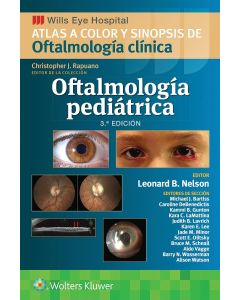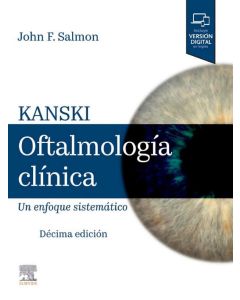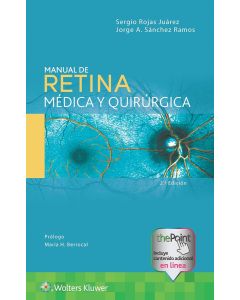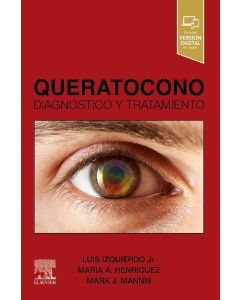Ophthalmology
Incluye Gastos de Importación
-
Especialidad
- Oftalmología
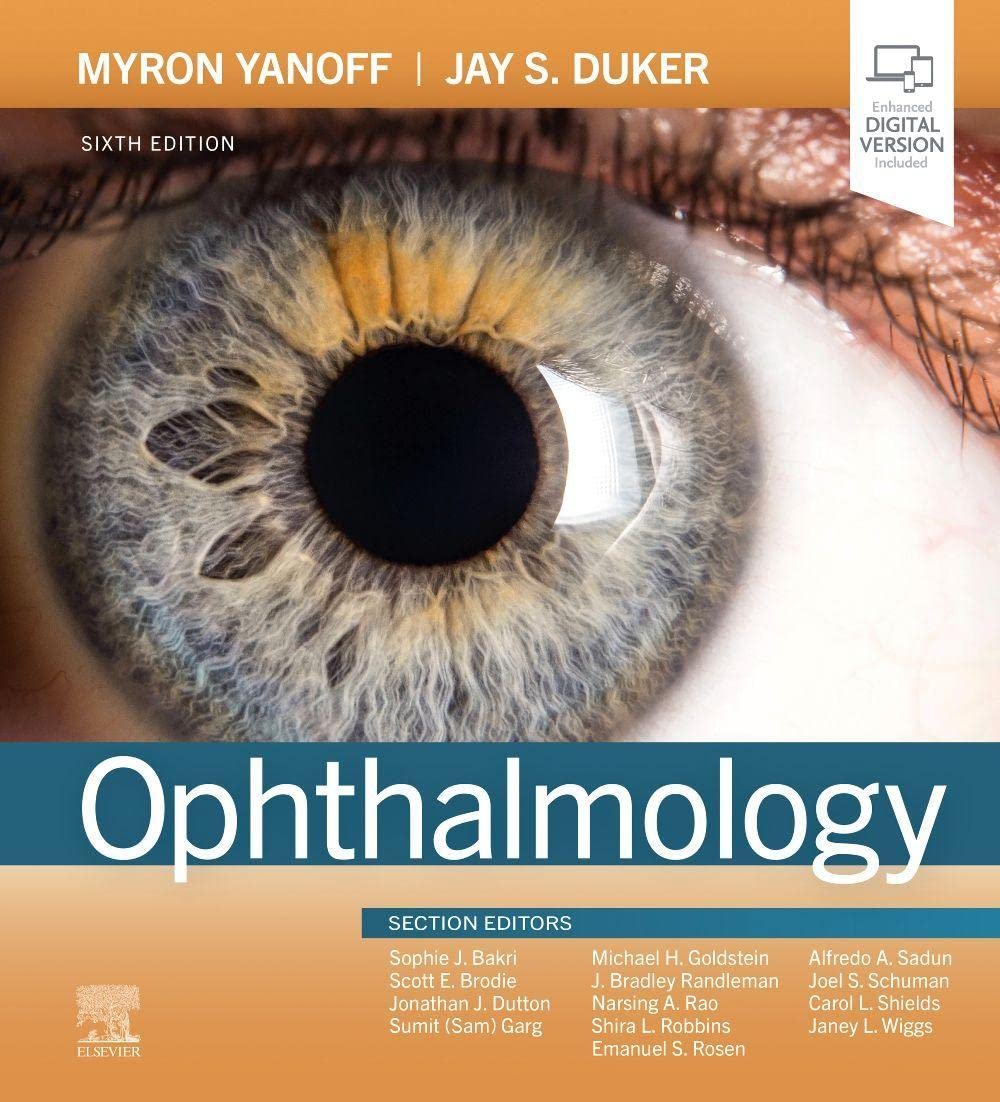
PART 1 GENETICS
1.1 Fundamentals of Human Genetics
1.2 Molecular Genetics of Selected Ocular Disorders
1.3 Genetic Testing and Genetic Counseling
PART 2 OPTICS AND REFRACTION
2.1 Light
2.2 Optics of the Human Eye
2.3 Clinical Refraction
2.4 Correction of Refractive Errors
2.5 Ophthalmic Instruments
2.6 Wavefront Optics and Aberrations of the Eye
PART 3 REFRACTIVE SURGERY
3.1 Current Concepts, Classification, and History of Refractive Surgery
3.2 Preoperative Evaluation for Refractive Surgery
3.3 Excimer Laser Surface Ablation: Photorefractive Keratectomy (PRK), Laser-Assisted Subepithelial Keratomileusis (LASEK), and Epi-LASIK
3.4 Laser-Assisted In Situ Keratomileusis (LASIK)
3.5 Small Incision Lenticule Extraction
3.6 Wavefront and Topography-Based Excimer Laser Refractive Surgery
3.7 Phakic Intraocular Lenses
3.8 Intrastromal Corneal Ring Segments: Synthetic and CAIRS
3.9 Surgical Treatment of Presbyopia
3.10 Excimer Laser Phototherapeutic Keratectomy
3.11 Corneal Cross-linking
PART 4 CORNEA AND OCULAR SURFACE DISEASES
SECTION 1: BASIC PRINCIPLES
4.1 Corneal Anatomy, Physiology, and Wound Healing
4.2 Anterior Segment Imaging Modalities
SECTION 2: CONGENITAL ABNORMALITIES
4.3 Congenital Corneal Anomalies
SECTION 3: EXTERNAL DISEASES
4.4 Blepharitis
4.5 Herpes Zoster Ophthalmicus
SECTION 4: CONJUNCTIVAL DISEASES
4.6 Infectious Conjunctivitis
4.7 Allergic Conjunctivitis
4.8 Tumors of the Conjunctiva
4.9 Pterygium and Conjunctival Degenerations
4.10 Ocular Cicatricial Pemphigoid/Mucous Membrane Pemphigoid
SECTION 5: SCLERAL AND EPISCLERAL DISEASES
4.11 Episcleritis and Scleritis
SECTION 6: CORNEAL DISEASES
4.12 Bacterial Keratitis
4.13 Fungal Keratitis
4.14 Parasitic Keratitis
4.15 Herpes Simplex Keratitis
4.16 Peripheral Ulcerative Keratitis
4.17 Noninfectious Keratitis
4.18 Keratoconus and Other Ectasias
4.19 Anterior Corneal Dystrophies
4.20 Stromal Corneal Dystrophies
4.21 Diseases of the Corneal Endothelium
4.22 Corneal Degenerations
4.23 Dry Eye Disease
SECTION 7: MISCELLANEOUS CONDITIONS
4.24 Complications of Contact Lens Wear
4.25 Corneal and External Eye Manifestations of Systemic Disease
SECTION 8: TRAUMA
4.26 Acid and Alkali Burns
SECTION 9: SURGERY
4.27 Endothelial Keratoplasty: Targeted Treatment for Corneal Endothelial Dysfunction
4.28 Penetrating Keratoplasty
4.29 Anterior Lamellar Keratoplasty
4.30 Superficial Corneal Procedures and Corneal Collagen Cross-linking
4.31 Artificial Cornea (Keratoprosthesis)
4.32 Conjunctival Surgery
4.33 Surgical Ocular Surface Reconstruction
4.34 Management of Corneal Thinning, Melting, and Perforation
PART 5 THE LENS
5.1 Basic Science of the Lens
5.2 Evolution of Intraocular Lens Implantation
5.3 Intraocular Lens Optics
5.4 Bag-in-the-Lens Cataract Surgery
5.5 Epidemiology, Pathophysiology, Causes, Morphology, and Visual Effects of Cataract
5.6 Patient Workup for Cataract Surgery
5.7 Intraocular Lens Power Calculations
5.8 Indications for Lens Surgery/Indications for Application of Different Lens Surgery Techniques
5.9 The Pharmacotherapy of Cataract Surgery
5.10 Anesthesia for Cataract Surgery
5.11 Phacoemulsification Fluidics
5.12 Refractive Aspects of Cataract Surgery
5.13 Small-Incision and Femtosecond Laser-Assisted Cataract Surgery
5.14 Capsulectomy: Modern Devices Apart From FLACS
5.15 Manual Cataract Extraction
5.16 Combined Procedures
5.17 Cataract Surgery in Complex Eyes
5.18 Pediatric Cataract Surgery
5.19 Complications of Cataract Surgery
5.20 Secondary Cataract
5.21 Outcomes of Cataract Surgery
PART 6 RETINA AND VITREOUS
SECTION 1: ANATOMY
6.1 Structure of the Neural Retina and Retinal Pigment Epithelium
6.2 Retinal and Choroidal Circulation
SECTION 2: ANCILLARY TESTS
6.3 Contact B-Scan Ultrasonography
6.4 Camera-Based Ancillary Retinal Testing: Autofluorescence, Fluorescein, and Indocyanine Green Angiography
6.5 Optical Coherence Tomography in Retinal Imaging
6.6 Optical Coherence Tomography Angiography
6.7 Retinal Electrophysiology
SECTION 3: BASIC PRINCIPLES OF RETINAL SURGERY
6.8 Light and Laser Injury
6.9 Scleral Buckling Surgery
6.10 Vitrectomy
6.11 Intravitreal Injections and Medication Implants
SECTION 4: DYSTROPHIES
6.12 Progressive and “Stationary Inherited Retinal Degenerations
6.13 Inherited Retinal Diseases
SECTION 5: VASCULAR DISORDERS
6.14 Hypertensive Retinopathy
6.15 Retinal Arterial Obstruction
6.16 Venous Occlusive Disease of the Retina
6.17 Retinopathy of Prematurity
6.18 Diabetic Retinopathy
6.19 Ocular Ischemic Syndrome
6.20 Hemoglobinopathies
6.21 Coats’ Disease and Macular Telangiectasia
6.22 Radiation Retinopathy and Papillopathy
6.23 Retinal Arterial Macroaneurysms
SECTION 6: MACULAR DISORDERS
6.24 Age-Related Macular Degeneration
6.25 Secondary Causes of Choroidal Neovascularization
6.26 Central Serous Chorioretinopathy
6.27 Full-Thickness Macular Hole
6.28 Epiretinal Membrane
6.29 Vitreomacular Traction
6.30 Cystoid Macular Edema
SECTION 7: RETINAL DETACHMENT
6.31 Peripheral Retinal Lesions and Retinal Breaks
6.32 Rhegmatogenous Retinal Detachment
6.33 Serous Detachments of the Neural Retina
6.34 Suprachoroidal Hemorrhage
6.35 Proliferative Vitreoretinopathy
SECTION 8: TRAUMA
6.36 Posterior Segment Ocular Trauma
6.37 Distant Trauma With Posterior Segment Effects
6.38 Retinal Toxicity of Systemically Administered Drugs
PART 7 UVEITIS AND OTHER INTRAOCULAR INFLAMMATIONS
SECTION 1: BASIC PRINCIPLES
7.1 Anatomy of the Uvea
7.2 General Approach to the Uveitis Patient and Treatment Strategies
SECTION 2: INFECTIOUS CAUSES OF UVEITIS—VIRAL
7.3 Herpetic Viral Uveitis
7.4 Nonherpetic Viral Infections: West Nile, Chikungunya, Zika, Ebola, HTLV-I, Measles, Rubella
SECTION 3: INFECTIOUS CAUSES OF UVEITIS—BACTERIAL
7.5 Syphilitic and Other Spirochetal Uveitis
7.6 Tuberculosis, Leprosy, and Brucellosis
7.7 Bartonella-Related Infectious Uveitis (Cat Scratch Disease) and Whipple’s Disease
7.8 Infectious Endophthalmitis
SECTION 4: INFECTIOUS CAUSES OF UVEITIS—FUNGAL
7.9 Histoplasmosis
7.10 Fungal Endophthalmitis
SECTION 5: INFECTIOUS CAUSES OF UVEITIS—PROTOZOAL AND PARASITIC
7.11 Ocular Toxoplasmosis
7.12 Posterior Parasitic Uveitis
SECTION 6: UVEITIS ASSOCIATED WITH SYSTEMIC DISEASE
7.13 Uveitis Related to HLA-B27 and Juvenile Idiopathic Arthritis– Associated Uveitis
7.14 Sarcoidosis
7.15 Behçet’s Disease
7.16 Vogt–Koyanagi–Harada Disease
SECTION 7: TRAUMATIC UVEITIS
7.17 Phacogenic Uveitis
7.18 Sympathetic Uveitis
SECTION 8: UVEITIS OF UNKNOWN CAUSES
7.19 Idiopathic and Other Anterior Uveitis Syndromes
7.20 Pars Planitis and Other Intermediate Uveitides
7.21 Posterior Uveitis of Unknown Cause—White Spot Syndromes
SECTION 9: MASQUERADE SYNDROMES
7.22 Masquerade Syndromes: Neoplasms
PART 8 INTRAOCULAR TUMORS
8.1 Tumors of the Retina and Optic Disc
8.2 Tumors of the Uvea
8.3 Tumors (Solid and Cystic) of the Pigmented and Nonpigmented Epithelium
8.4 Phakomatoses
PART 9 NEURO-OPHTHALMOLOGY
SECTION 1: IMAGING IN NEURO-OPHTHALMOLOGY
9.1 Principles of Imaging in Neuro-ophthalmology
9.2 Optical Coherence Tomography in Neuro-ophthalmology
SECTION 2: THE AFFERENT VISUAL SYSTEM
9.3 Anatomy and Physiology
9.4 Differentiation of Optic Nerve From Macular Retinal Disease
9.5 Congenital Optic Disc Anomalies
9.6 Papilledema and Raised Intracranial Pressure
9.7 Inflammatory Optic Neuropathies and Neuroretinitis
9.8 Ischemic Optic Neuropathy
9.9 Mitochondrial Optic Neuropathies
9.10 Prechiasmal Pathways—Compression by Optic Nerve and Sheath Tumors
9.11 Traumatic Optic Neuropathies
9.12 Lesions of the Optic Chiasm, Parasellar Region, and Pituitary Fossa
9.13 Lesions of Retrochiasmal Pathways, Higher Cortical Function, and Nonorganic Visual Loss
SECTION 3: THE EFFERENT VISUAL SYSTEM
9.14 Disorders of Supranuclear Control of Ocular Motility
9.15 Nuclear and Fascicular Disorders of Eye Movement
9.16 Paresis of Isolated and Multiple Cranial Nerves and Painful Ophthalmoplegia
9.17 Disorders of the Neuromuscular Junction
9.18 Ocular Myopathies
9.19 Nystagmus, Saccadic Intrusions, and Oscillations
9.20 Pupillary Signs of Neuro-ophthalmic Disease
SECTION 4: THE BRAIN
9.21 Headache and Facial Pain
9.22 Tumors, Infections, Inflammations, and Neurodegenerations
SECTION 5: NEURO-OPHTHALMOLOGIC EMERGENCIES
9.23 Urgent Neuro-ophthalmic Disorders
9.24 Trauma, Drugs, and Toxins
9.25 Vascular Disorders
9.26 Electrophysiology
PART 10 GLAUCOMA
SECTION 1: EPIDEMIOLOGY AND MECHANISMS OF GLAUCOMA
10.1 Epidemiology of Glaucoma
10.2 Screening for Glaucoma
10.3 Mechanisms of Glaucoma
SECTION 2: EVALUATION AND DIAGNOSIS
10.4 Clinical Examination of Glaucoma
10.5 Visual Fields
10.6 Diagnostic Technologies
10.7 Optic Nerve Blood Flow Measurement
10.8 Ocular Hypertension
SECTION 3: SPECIFIC TYPES OF GLAUCOMA
10.9 Primary Open-Angle Glaucoma
10.10 Normal-Tension Glaucoma
10.11 Angle-Closure Glaucoma
10.12 Glaucoma Associated With (Pseudo)Exfoliation Syndrome
10.13 Pigmentary Glaucoma
10.14 Neovascular Glaucoma
10.15 Inflammatory and Corticosteroid-Induced Glaucoma
10.16 Glaucoma Associated With Ocular Trauma
10.17 Glaucoma With Elevated Episcleral Venous Pressure
10.18 Malignant Glaucoma
10.19 Glaucomas Secondary to Abnormalities of the Cornea, Iris, Retina, and Intraocular Tumors
10.20 Congenital Glaucoma
SECTION 4: THERAPY
10.21 When to Treat Glaucoma
10.22 Current Medical Management of Glaucoma
10.23 Laser Trabeculoplasty and Laser Peripheral Iridectomy
10.24 Cyclodestructive Procedures in Glaucoma
10.25 Goniotomy and Trabeculotomy
10.26 Microinvasive Glaucoma Surgeries
10.27 Trabeculectomy
10.28 Antifibrotic Agents in Glaucoma Surgery
10.29 Drainage Implants
10.30 Complications of Glaucoma Surgery and Their Management
10.31 Genes Associated With Human Glaucoma
10.32 Evidence-Based Medicine in Glaucoma
PART 11 PEDIATRIC AND ADULT STRABISMUS
SECTION 1: BASIC SCIENCE
11.1 Anatomy and Physiology of the Extraocular Muscles and Surrounding Tissues
SECTION 2: EVALUATION AND DIAGNOSIS
11.2 Evaluating Vision in Preverbal and Preliterate Infants and Children
11.3 Examination of Ocular Alignment and Eye Movements
11.4 Sensory Status in Strabismus
11.5 Sensory Adaptations in Strabismus
SECTION 3: OCULAR MANIFESTATIONS
11.6 Esotropia
11.7 Exotropia
11.8 Torsional Strabismus
11.9 Paralytic Strabismus
11.10 Other Vertical Strabismus Forms
11.11 Amblyopia 1169
SECTION 4: TREATMENT
11.12 Forms of Nonsurgical Strabismus Management
11.13 Techniques of Strabismus Surgery
PART 12 ORBIT AND OCULOPLASTICS
SECTION 1: ORBITAL ANATOMY AND IMAGING
12.1 Clinical Anatomy of the Eyelids
12.2 Clinical Anatomy of the Orbit
12.3 Orbital Imaging
SECTION 2: EYELIDS
12.4 Blepharoptosis
12.5 Entropion
12.6 Ectropion
12.7 Benign Eyelid Lesions
12.8 Eyelid Malignancies
12.9 Evaluation and Management of Periorbital Soft Tissue Trauma
SECTION 3: ORBIT AND LACRIMAL GLAND
12.10 Orbital Diseases
12.11 Enucleation, Evisceration, and Exenteration
12.12 The Lacrimal Drainage System
12.13 Thyroid Eye Disease
12.14 Orbital Infection and Inflammation
SECTION 4: PERIORBITAL AESTHETIC PROCEDURES
12.15 Cosmetic Blepharoplasty and Browplasty
12.16 Aesthetic Fillers and Botulinum Toxin for Wrinkle Reduction
Index


